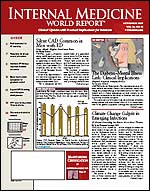Publication
Article
Internal Medicine World Report
Central Aortic BP Better Predictor of CV Events than Brachial BP
May Have Significant Implications for Treatment
Central Aortic BP Better Predictor of CV Events than Brachial BP
Dallas—Central aortic blood pressure (BP) better predicts the risk of cardiovascular (CV) events than brachial BP, said investigators at the American Heart Association’s Scientific Sessions 2005. Furthermore, drugs that reduce brachial BP similarly can have different effects on central BP, they reported.
“Brachial blood pressure is an imperfect surrogate for the effects of blood pressure—lowering drugs on central aortic pressures,” said Bryan Williams, MD, of the University of Leicester, United Kingdom. “Moreover, central pressure appears to be an important determinant of clinical outcomes.”
To examine the relative strengths of central aortic and brachial pressures in predicting CV disease, Mary J. Roman, MD, of the University of Oklahoma Health Sciences Center, Oklahoma City, and colleagues studied 2409 patients free of CV disease at baseline.
The patients underwent radial applanation tonometry to calculate central aortic BP and brachial BP measures using mercury sphygomanometry. They were then followed for about 3.5 years.
After adjusting for confounders that included the presence of carotid atherosclerosis, aortic pulse pressure and arterial stiffness were independently predictive of CV events, whereas brachial BP was not.
When CV events were analyzed by tertiles of aortic pulse pressure, “there was a stepwise increase from the first to the second and third tertiles for the proportion of events,” said Dr Roman. A similar relationship was found between tertiles of arterial stiffness and incidence of CV events.
In explaining the superiority of arterial stiffness and central BP to peripheral BP in predicting incident CV disease, she explained that “arterial stiffness and central pulse pressure more accurately represent the prognostic importance of vascular load on the left ventricle and its impact on cerebral and coronary arteries than does peripheral blood pressure.”
Dr Williams presented data from the Conduit Artery Function Evaluation (CAFÉ), which was a substudy of the Anglo-Scandinavian Cardiac Outcomes Trial (ASCOT). In CAFÉ, 2199 patients had their brachial BP measured and had central aortic pressures derived by using a noninvasive computer program that examines the shape of the pulse wave at the wrist.
In the larger ASCOT study, effects of 2 antihypertensive regimens were compared: a regimen of amlodipine (Norvasc) plus perindopril (Aceon) versus atenolol (Tenormin) plus a thiazide diuretic in 19,257 hypertensives; results showed significant reductions in CV and renal outcomes and overall death in the patients assigned to the amlodipine-perindopril combination.
Although brachial BP differed little between the treatment groups in CAFÉ, substantial reductions in trial-averaged values for central aortic pressures and hemodynamic values were observed in the amlodipine-perindopril group. Central aortic systolic BP was 4.3 mm Hg and the central aortic pulse pressure was 3.0 mm Hg lower with the amlodipine-perindopril regimen compared with the beta-blocker—thiazide diuretic regimen.
In CAFÉ, central pulse pressure was a significant determinant of total CV and renal end points, said Dr Williams.
“These findings provide a novel mechanism to explain the different clinical outcomes between the 2 blood pressure treatment arms in ASCOT and potentially other blood pressure-lowering treatment trials,” he said. They may also have significant implications for treatment guidelines. —W.K.
